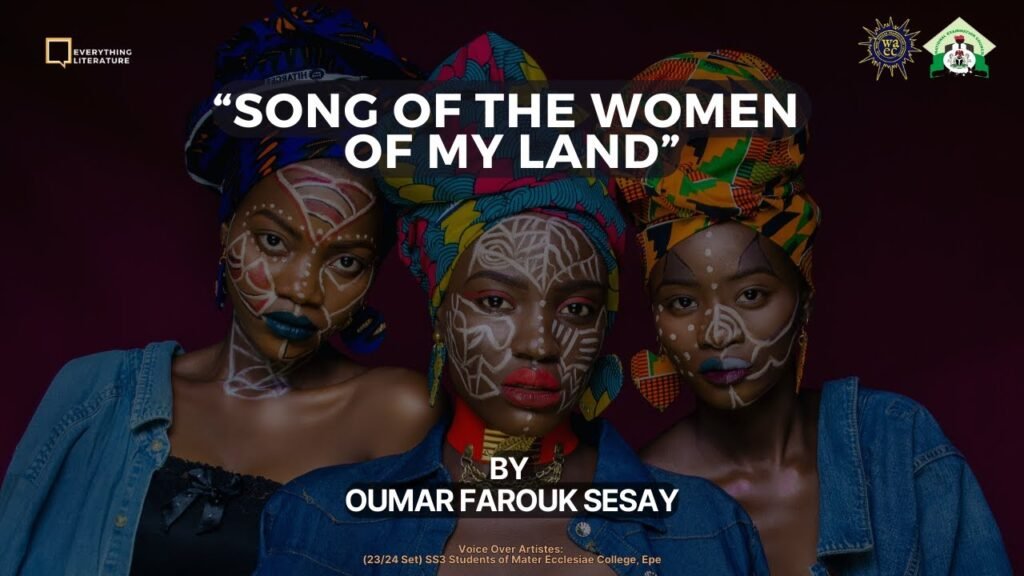Oumar Farouk Sesay’s The Song of the Women of My Land is a powerful, evocative poem that sheds light on the struggles and resilience of women, particularly those in Africa. Through vivid imagery and deep emotion, Sesay narrates the story of women who endured immense hardship, laboring in the fields and carrying burdens that were often invisible and unacknowledged. Their stories, once conveyed through songs, are now fading, but they still resonate through the words of poets and the collective memory.
Themes in The Song of the Women of My Land
- The Passage of Time: One of the central themes of the poem is the passage of time and its ability to erase memories and songs. Sesay uses the metaphor of a sculptor chiseling away at wood to describe how time strips away the details of the women’s songs. This suggests how history often forgets the stories of marginalized people, especially those whose voices have been silenced.
- The Power of Song: The song in the poem is not just a melody; it is a means of survival and resistance. The women of the land used their songs to communicate their pain, celebrate their small victories, and keep their history alive. The song is a metaphor for the women’s resilience—their way of claiming space and asserting their dignity despite oppressive forces.
- The Struggles of Women: The poem speaks directly to the servitude and suffering endured by these women. The line “when servitude cuffed the ankles of their soul” captures the harshness of their lives, shaped by social expectations, labor, and the often brutal realities of their existence. The song becomes an act of defiance against the forces that sought to erase their contributions.
- The Loss of Memory and Legacy: Sesay reflects on how time robs the women of their songs and memories. The fading tune is symbolic of how the legacies of these women are often forgotten, their labor and pain unrecognized. The song, once a source of strength, becomes a “dying song,” hinting at how history neglects the voices of those who have struggled.
- The Role of Poets: The poet, in this case, is not only a witness but also a custodian of the women’s stories. Sesay, through his writing, attempts to revive the dying song, bringing attention to the forgotten women and their songs of hardship, labor, and resistance. The poet’s pen and voice struggle to resurrect what time has buried.
Symbolism and Literary Devices in the Poem
- Metaphor: Sesay compares time to a sculptor, chiseling away at memories and songs. This powerful metaphor illustrates how time gradually erases the past, stripping it of its original meaning and beauty.
- Repetition: The recurring reference to the song throughout the poem emphasizes its importance and the loss it represents. The song is the women’s only surviving legacy, and its fading is a poignant symbol of their struggles being forgotten.
- Personification: The “tune” of the song is given life, as it “roams the forlorn fields” and “echoes in wriggling rhythms and melodies.” This personification gives the song agency, implying that even as it fades, it continues to search for its lost lyrics.
- Imagery: Sesay uses vivid imagery to paint a picture of the women’s labor and suffering. The “forlorn fields” and “dying song” evoke a sense of desolation, while the “winds” and “verses of poets” symbolize the lingering presence of the women’s legacy.
- Juxtaposition: There is a stark contrast between the lives of the women—marked by hardship and servitude—and the poetic attempt to capture their story. This juxtaposition highlights the struggle to keep the women’s memories alive in a world that often forgets them.
The Relevance of the Poem Today
Oumar Farouk Sesay’s poem speaks not only to the struggles of women in the past but also to the ongoing fight for gender equality, recognition, and justice. The issues faced by the women in the poem—being silenced, ignored, and exploited—continue to affect many women today. The poem serves as a reminder of the importance of remembering and honoring the contributions of women, especially those whose labor often goes unnoticed.
In many societies, women still face systemic barriers, and their voices are often marginalized. Sesay’s poem calls for a deeper acknowledgment of their struggles and a commitment to ensuring that their stories are heard and valued.
Conclusion
The Song of the Women of My Land by Oumar Farouk Sesay is a hauntingly beautiful meditation on memory, loss, and the resilience of women. Through the metaphor of the song, Sesay captures the essence of how the voices of the oppressed can be silenced by time, yet still resonate in the words of poets and the collective consciousness. The poem is a tribute to the strength and endurance of women, urging us to remember their struggles and honor their legacies.
By reading and reflecting on this poem, we are called to action—to ensure that the stories of those who have been silenced are brought to the forefront, their songs remembered, and their histories preserved.
Objective Questions and Answers on The Song of the Women of My Land
- Who is the author of The Song of the Women of My Land?
- A) Chinua Achebe
- B) Oumar Farouk Sesay
- C) Wole Soyinka
- D) Ngũgĩ wa Thiong’o
- Answer: B) Oumar Farouk Sesay
- What does the song represent in the poem?
- A) The victory of the women
- B) The labor and suffering of women
- C) A celebration of life
- D) A romantic love song
- Answer: B) The labor and suffering of women
- What is the metaphor used to describe the passage of time in the poem?
- A) Time is a river
- B) Time is a sculptor
- C) Time is a thief
- D) Time is a shadow
- Answer: B) Time is a sculptor
- What does the “dying song” symbolize in the poem?
- A) The fading memory of the women’s struggles
- B) A celebration of African heritage
- C) A joyful tune of victory
- D) The defeat of the women
- Answer: A) The fading memory of the women’s struggles
- What is the role of poets in the poem?
- A) To forget the past
- B) To sing the women’s song
- C) To erase the pain of history
- D) To celebrate time
- Answer: B) To sing the women’s song
- What does the “forlorn fields” refer to in the poem?
- A) The rich land of Africa
- B) The place where the women worked and suffered
- C) The land of freedom
- D) The resting place of the women
- Answer: B) The place where the women worked and suffered
- What does the “memory of the wind” symbolize?
- A) The forgotten song of the women
- B) The joy of the people
- C) The silence of the land
- D) The winds of change
- Answer: A) The forgotten song of the women
- What does “servitude cuffed the ankles of their soul” suggest?
- A) The freedom of women
- B) The soul-crushing labor of the women
- C) The joy of the women’s work
- D) The empowerment of women
- Answer: B) The soul-crushing labor of the women
- Which of the following literary devices is most prominent in the poem?
- A) Hyperbole
- B) Personification
- C) Irony
- D) Onomatopoeia
- Answer: B) Personification
- What does the “dying song” represent?
- A) The end of African culture
- B) The women’s lost voices
- C) A celebration of death
- D) A triumphant tune
- Answer: B) The women’s lost voices
- What does the poet’s pen and rib symbolize?
- A) The poet’s struggle to express the women’s pain
- B) The joy of writing poetry
- C) The ease of creating art
- D) The poet’s physical pain
- Answer: A) The poet’s struggle to express the women’s pain
- What is the central theme of the poem?
- A) The celebration of women’s freedom
- B) The loss of memory and the fading of women’s songs
- C) The prosperity of the land
- D) The happiness of the women’s lives
- Answer: B) The loss of memory and the fading of women’s songs
- How does time affect the women’s song?
- A) Time preserves the song
- B) Time erases the song’s lyrics
- C) Time enhances the song’s beauty
- D) Time has no effect on the song
- Answer: B) Time erases the song’s lyrics
- What does “ploughing their soil and soul” symbolize?
- A) The physical labor and emotional toil of the women
- B) The growth of the land
- C) The women’s freedom
- D) The celebration of life
- Answer: A) The physical labor and emotional toil of the women
- What does the wind represent in the poem?
- A) The women’s freedom
- B) The past, now lost and fading
- C) The birth of a new generation
- D) The strength of the women
- Answer: B) The past, now lost and fading
- What does the poet struggle to do in the poem?
- A) To forget the women’s story
- B) To sing the women’s song
- C) To celebrate the women’s victory
- D) To erase the pain of the past
- Answer: B) To sing the women’s song
- What does “dying song” imply?
- A) The fading legacy of the women
- B) The triumphant end of the women’s struggles
- C) A celebration of the women’s freedom
- D) The joy of their labor
- Answer: A) The fading legacy of the women
- What does the poem ultimately convey about the women?
- A) They were forgotten and ignored
- B) They were strong, resilient, and their stories should be remembered
- C) They lived lives of happiness
- D) They achieved their goals
- Answer: B) They were strong, resilient, and their stories should be remembered
- What emotion dominates the poem?
- A) Joy
- B) Sadness
- C) Anger
- D) Hope
- Answer: B) Sadness
- What is the significance of the dying song in the poem?
- A) It symbolizes the unfulfilled dreams of the women
- B) It symbolizes the triumph of the women
- C) It symbolizes the enduring strength of women
- D) It symbolizes the erasure of their lives and struggles
- Answer: D) It symbolizes the erasure of their lives and struggles

